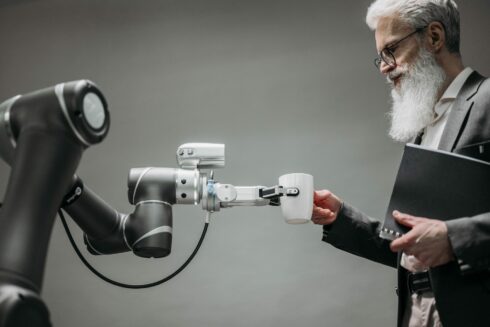
In 2023, AI technologies made their way through the hype cycle. Companies researched it, maybe experimented with it, or at the very least, certainly spent a lot of time talking about it.
In 2024, it will be time to actually take the lessons learned from those experiments and begin implementing these technologies in real ways, on a larger scale. That’s why SD Times is declaring 2024 the year of AI implementation.
A few months ago, the tech analyst firm Gartner made the prediction that more than 80% of enterprises will have used generative AI APIs or deployed generative AI-enabled applications by 2026.
RELATED CONTENT: Year in Review: AI
According to Cameron van Orman, chief strategy officer at Planview, in 2024 we will see a transition from the initial hype around AI to more pragmatic expectations.
“Overall, this marks a pivotal moment, signaling a more mature and purpose-driven era for generative AI. With this, attention will shift from ‘enablers’ to application, highlighting how enterprises are directing investments toward initiatives that drive efficiency and meaningful change,” van Orman said.
Companies will question how AI can provide value
According to Molham Aref, founder and CEO of RelationalAI, the “extreme overhype” of generative AI will start to decrease this year.
Organizations are going to start deploying generative AI in more measured ways, and companies will be able to better calibrate their expectations once they can see the true impact, he explained.
Miroslav Klivansky, analytics and global practice lead at Pure Storage, added: “As a whole, the bar for understanding and harnessing the full value of AI is still low but it won’t be for long as market pressures continue to accelerate AI adoption. The future of enterprise AI will be centered on AI being built into the products and services already in use. But as AI innovation evolves, we’ll see enterprises learn to build their own in-house AI data platform and move part of the workflows into their own infrastructure,” he said.
Klivansky also recommends that companies invest in building in-house expertise. Having a “center of excellence” for AI will be better than having individual AI projects that are scattered throughout the companies, he explained.
Wing To, general manager of Intelligent DevOps at Digital.ai, predicts that the “first mover advantage” will disappear and best practices will emerge. “By the end of 2024, those who have adopted AI-assisted code tools and cracked the code on how to use AI well will be outperforming companies that are not,” he said.
The AI market will start to consolidate
Over the past year, many new startups sprang up hoping to capitalize on the hype around generative AI. According to data from Crunchbase, in 2023, 25% of technology investments in America went into AI-related companies.
Aref also noted that the venture capital climate has been difficult lately and that will continue into 2024. He predicts a “survival of the fittest” among AI companies. AI companies will start to either shut down or get acquired by larger companies.
“I think there will be an evolutionary cycle for the companies that can survive the next 18 months or so,” said Aref. “It has been said before that some of the best and most valuable companies are usually created in difficult times, like during the 2008 recession and in 2000 when the dot-com bubble burst, as they usually tend to have better products and more disciplined companies. Companies that can run efficiently, be agile, and can adapt quickly to tough situations will be better positioned. At the end of the day, companies that have a strong product, and a demonstrated value proposition, will be in a better position to outrun the competition.”
Is the Chief AI Officer role here to stay?
There was talk in 2023 of companies needing a new role, the Chief AI Officer. In a survey published in the latter half of 2023, Foundry revealed that 15% of organizations already had a Chief AI Officer (CAIO), while 24% of respondents were looking for one.
In an episode of SD Times’ podcast What the Dev?, Patrick Dougherty, co-founder and CEO of Rasgo, argues that the roles of CIO and CAIO will work together. He says that companies can’t run IT anymore without thinking about how they’re integrating AI into data, applications, systems, and infrastructure.
“If I’m a CIO, I would actually prefer to get that ‘A’ in front of the ‘I.’ I think that’s good for everyone, so that’s probably the way it’ll go,” he said.
Prince Kohli, CTO of Automation Anywhere argues that the CAIO is short-lived and that it’s actually the CTO who will become the natural choice for steering AI strategy. This is because AI will require cohesive integration into the broader technology and business strategies of a company.
“The CTO will educate and guide the rest of the c-suite on the value of AI, a strategic shift that places AI at the heart of more business decisions,” he said.
Impact of regulations on data privacy, AI
In 2023, several governments made it a point to try to begin regulating AI as its popularity soared. The United States issued an Executive Order on AI in October, which “establishes new standards for AI safety and security, protects Americans’ privacy, advances equity and civil rights, stands up for consumers and workers, promotes innovation and competition, advances American leadership around the world, and more.”
The European Union (EU) also reached a provisional agreement for new AI regulation, which has a goal of ensuring that AI systems are safe and “respect fundamental rights and EU values,” the European Council explained.
Using AI in the enterprise will also require companies to comply with existing data privacy regulations. According to Matt Waxman, SVP and GM at Veritas Technologies, over the last year, organizations that experienced a data breach resulting in regulatory noncompliance racked up an average of USD$336,000 in fines.
Therefore, he said, companies need to put the proper guardrails in place to ensure that employees who are using generative AI tools are not potentially breaking data privacy regulations.
“Right now, most regulatory bodies are focused on how existing data privacy laws apply to generative AI, but as the technology continues to evolve, expect generative AI-specific legislation in 2024 that applies rules directly to these tools and the data used to train them,” Waxman said.
In fact, Chris Patrick, senior vice president and general manager for mobile handset at Qualcomm, believes that companies that communicate their focus on personal privacy well will have a market advantage.
Generative AI moves to the edge, with new modalities
There will also be a push to move generative AI processing to the edge, according to Durga Malladi, senior vice president and general manager of Technology Planning & Edge Solutions at Qualcomm.
This in turn may help with privacy and security needs, because sensitive data stays on the device, rather than being sent back and forth to the cloud, he explained.
“As generative AI becomes more integrated in our lives, our personal devices like our smartphones, PCs, and even vehicles, will become the hubs for multi-modal generative AI models,” said Malladi. “This transition will bring next-level AI experiences to consumers and not only cuts down cloud costs for developers but also ushers in an era of privacy-focused, personalized experiences. Additionally, with the models working on the technology in our hands, the shift from cloud-based to hybrid or on-device AI will take a dramatic leap.”
Qualcomm’s Patrick predicts that generative AI will start to combine on-device sensor data with multimodal models — those that can take in multiple data types, like text, audio, and images — to move from generic responses to personalized, informative outcomes.
“By using different modalities, these AI assistants will enable natural engagement and be able to process and generate text, voice, images and even videos, solely on-device,” said Patrick. “This will bring next-level user experience to the mainstream and also address the escalating costs of cloud-based AI.”
Multimodal already has started to gain traction. In 2023, Google unveiled a new multimodal model called Gemini, and OpenAI also updated ChatGPT to allow it to use images and voice.
According to Ashok Srivastava, senior vice president and chief data officer at Intuit, the switch to multimodal models will enable AI systems to make use of more real-world examples, thus reducing hallucinations, a phenomenon in which AI systems come up with responses that contain inaccurate information.
“As generative AI learns with sound, vision, and other senses, the near future may bring with it AI systems that can distinguish between reality and fiction,” he said.






